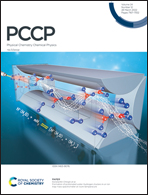Theoretical treatment of IO–X (X = N2, CO, CO2, H2O) complexes†
Abstract
Iodine monoxide (IO) is an important component of the biogeochemical cycle of iodine. For instance, it is present in the troposphere, where it plays a crucial role in the physical chemical processes involving iodine containing compounds. Here, we present a theoretical study on a series of atmospherically relevant complexes of IO with N2, CO, CO2 and H2O, where their structural and spectroscopic properties and their interaction energies are computed. Calculations are carried out by means of ab initio post Hartree–Fock (RCCSD(T) and RMP2) methods and density functional theory DFT (PBE0 and M05-2X) based approaches with and without the inclusion of dispersion correction. After comparison to RCCSD(T), we highlight the good performance of M05-2X(+D3) DFT in describing the bonding between IO and X (X = N2, CO, CO2, H2O). Moreover, we found that the IO–X (X = N2, CO, CO2, H2O) complexes are formed by non-covalent interactions between the two monomers. In sum, we characterized two types of complexes: I-bonded and O-bonded, where the former is more stable. The atmospheric implications of the present findings are also discussed such as in the formation of the iodine oxide particles (IOPs).

- This article is part of the themed collection: 2022 PCCP HOT Articles


 Please wait while we load your content...
Please wait while we load your content...